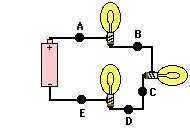| Admissions | Accreditation | A to Z Degree Fields | Booksellers | Catalog | Colleges | Contact Us | Continents/States/Districts | Contracts | Distance Education | Emergency | Emergency Medicine | Examinations | Forms | Grants | Hostels | Honorary Doctorate degree | Human Services | Internet | Investment | Instructors | Login | Lecture | Librarians | Membership | Observers | Professional Examinations | Programs | Progress Report | Recommendations | Research Grants | Researchers | Students login | School | Search | Seminar | Study Center/Centre | Sponsorship | Tutoring | Thesis | Universities | Work counseling |
|
Ampere http://www.rapidtables.com/electric/ampere.htm |
| Electric Current |
| Electrical units definitions |
|
Check Your Understanding 1. A current is said to exist whenever _____. a. a wire is charged b. a battery is present c. electric charges are unbalanced d. electric charges move in a loop Answer: D Current is the rate at which charge flows. Charge will not flow in a circuit unless there is an energy source capable of creating an electric potential difference and unless there is a closed conducting loop through which the charge can move. 2. Current has a direction. By convention, current is in the direction that ___. a. + charges move b. - electrons move c. + electrons move Answer: A By convention, the electric current direction is the direction which positive charge would move. In wires, the actual charge carriers are negatively charged electrons. Nonetheless, the convention used for the direction of current is based on the direction which positive charges would move. 3. The drift velocity of mobile charge carriers in electric circuits is ____. a. very fast; less than but very close to the speed of light b. fast; faster than the fastest car but nowhere near the speed of light c. slow; slower than Michael Jackson runs the 220-meters d. very slow; slower than a snail Answer: D The average speed of an electron within a circuit is very, very slow. This is due primarily to the countless collisions with the fixed atoms in the wire. Actual drift speeds depend upon numerous factors. A typical drift speed would be about 1 meter per hour. 4. If an electric circuit could be compared to a water circuit at a water park, then the current would be analogous to the ____. Choices: A. water pressure B. gallons of water flowing down slide per minute C. water D. bottom of the slide E. water pump F. top of the slide Answer: B Current is the rate at which something flows. Electric current is the rate at which electric charge flows past a point on the electric circuit. Water current is the rate at which water flows past a point on the water circuit. As such, current is analogous to the number of gallons of water flowing into, along, and out of a slide per unit of time. 5. The diagram at the right depicts a conducting wire. Two cross-sectional areas are located 50 cm apart. Every 2.0 seconds, 10 C of charge flow through each of these areas. The current in this wire is ____ A. a. 0.10 b. 0.25 c. 0.50 d. 1.0 e. 5.0 f. 20 g. 10 h. 40 i. none of these Answer: E Current is the ratio of charge to time. The quantity of charge passing through a cross section in 2 seconds is 10 C. The ratio of charge to time is I = Q / t = ( 10 C) / ( 2 s) = 5 C/s = 5 Ampere  6. Use the diagram at the right to complete the following statements: a. A current of one ampere is a flow of charge at the rate of _______ coulomb per second. b. When a charge of 8 C flows past any point along a circuit in 2 seconds, the current is ________ A. c. If 5 C of charge flow past point A (diagram at right) in 10 seconds, then the current is _________ A. d. If the current at point D is 2.0 A, then _______ C of charge flow past point D in 10 seconds. e. If 12 C of charge flow past point A in 3 seconds, then 8 C of charge will flow past point E in ________ seconds. f. True or False: The current at point E is considerably less than the current at point A since charge is being used up in the light bulbs.  To answer all these questions, use the mathematical equation for current: I = Q / t a. A current of one ampere is a flow of charge at the rate of 1 coulomb per second. b. When a charge of 8 coulombs flows past any point along a circuit in 2 seconds, the current is 4 A. c. If 5 coulombs of charge flow past point A (diagram at right) in 10 seconds, then the current is 0.5 A. d. If the current at point D is 2.0 A, then 20 coulombs of charge flow past point D in 10 seconds. e. If 12 coulombs of charge flow past point A in 3 seconds, then 8 coulombs of charge will flow past point E in 2 seconds. (The current is 12 C / 3 s or 4 Amperes at point A. Since current is everywhere the same, it is also 4 Amperes at point E. So the ratio of Q to t is 4 C / s.) f. False. The current is everywhere the same within an electric circuit. http://www.physicsclassroom.com/Class/energy/u5l1e.cfm http://www.qureshiuniversity.com/electricity.html |
